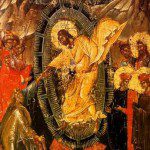
Anne Sexton once wrote of a child, “Love grew around her like crabgrass.” It’s one of my favorite of her many surprising lines, partly because it makes me smile and remember a particular child, and partly because it gets at something true about love: when it finds a place to take root, it spreads in all directions and finds new places to take root and cling. Love is rooting and branching everywhere—the life force that spins electrons and divides cells and gathers people in smiling, fascinated circles around small children.
A coach I worked with used the expression “in love” more broadly and precisely than most of us who associate it with a particularly besotted state of romantic attraction. When he spoke of a person who worked or played “in love,” he seemed to suggest that that person inhabited a particular zone of consciousness or state of awareness, or that love was a kind of weather bubble—a warm place of particular clarity where ambient light gathered. I think of the way he taught me to imagine love when I read Paul’s charge to the Ephesians, “Walk in love.”
Love, as Reg Presley’s song reminds us, is all around, and in our very bodies: “I feel it in my fingers, / I feel it in my toes.” Love flows and circulates. We receive it and release it like the breath our lives depend on. From the heart of God it comes to us like light from distant stars, unimaginably swift, burning through cold and darkness.
We are meant and designed to be light-bearers and agents of love. We are invited to dwell in God’s love and from that safe place, like a child looking out on the world from the safety of loving arms, to let our own circles of love ripple and widen with every encounter. We are truest to our own nature and most faithful to creation when we live lovingly.
But of course love has, as Virginia Woolf reminds us, a thousand shapes. A thousand faces. A thousand facets, each burning with its own brilliance. Like light, it splays and breaks into discrete colors, some of them dark. Love may be, as St. Paul writes, patient and kind, but it can also be edgy, articulate, able to speak truth to power, fierce with conviction and strong and mysterious as the power of an aikido master.
To live lovingly is to wield a force like a light saber and also to inhabit a force field in which everything is charged with life. And it is to discern prayerfully where and how to call forth that force in the service of the defenseless and the vulnerable. Now more than ever those prayers prepare us for the responsibilities we must take on as bombs are exploded in city streets and lobbed into olive groves where unsuspecting children play.
The great feast of Christmas reminds us of how a vulnerable child came into the world to bear and embody God’s own unfathomable love, arriving not in regal majesty, but needing human care, and subject to the imperfect, unpracticed human efforts: “Word within a word, unable to speak a word,” as T.S. Eliot mysteriously put it. The same love that exploded into galaxies lay sleeping in the arms of a young mother whose consent to his coming represented all human turning toward the Source of all love.
And so we celebrate. And so a thousand Madonnas are adorned and altars bedecked and homes “made fair” and gifts given and the poor more generously gathered and fed this time of year. And we, who wander like sheep into thickets of distraction and sloughs of greed are brought back into love, reminded, reassured, and released once again like those same sheep who “safely graze,” after all, beside streams of living water.
Image: Michelangelo Madonna, Church of San Lorenzo, Florence, Italy

















